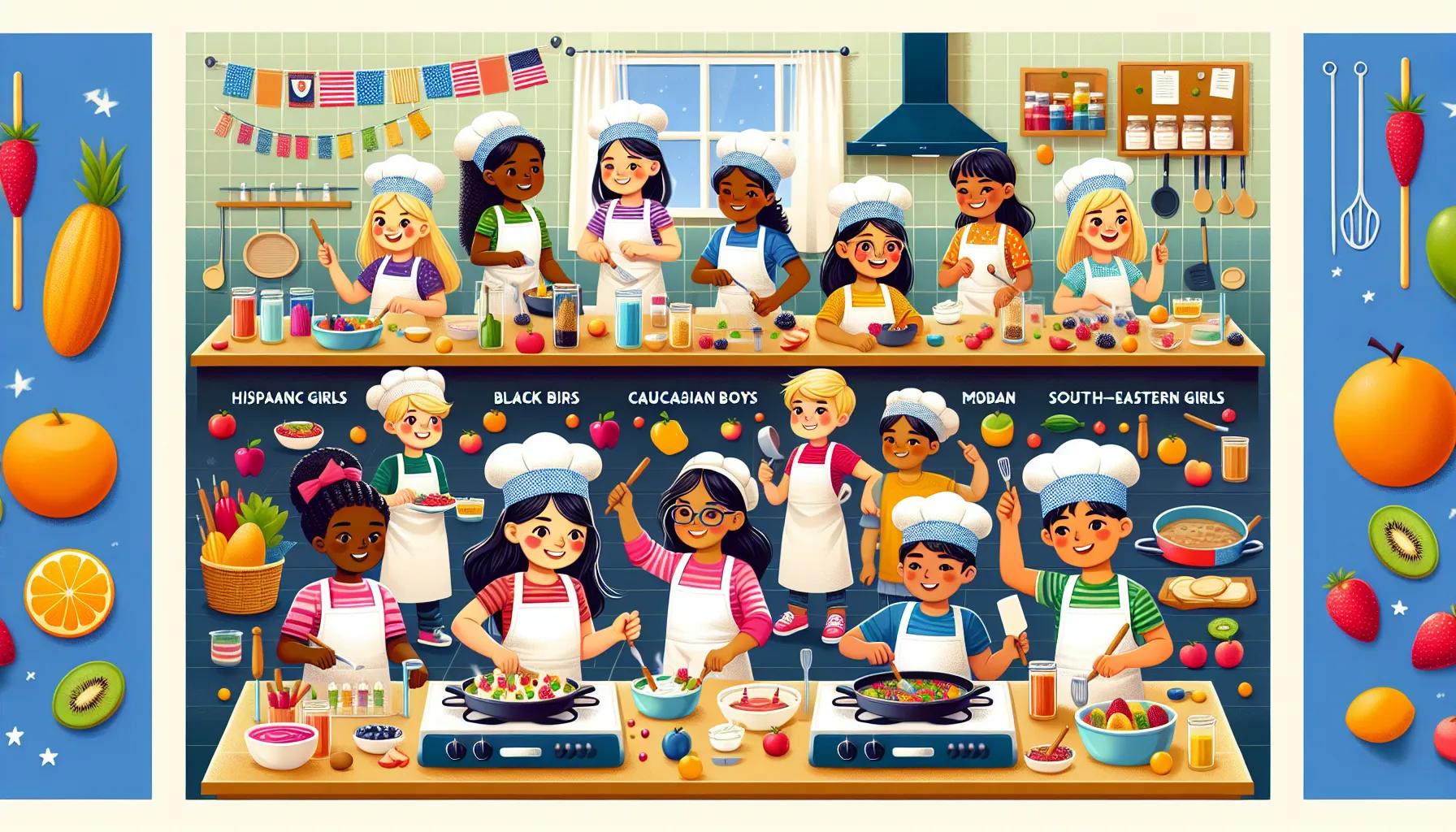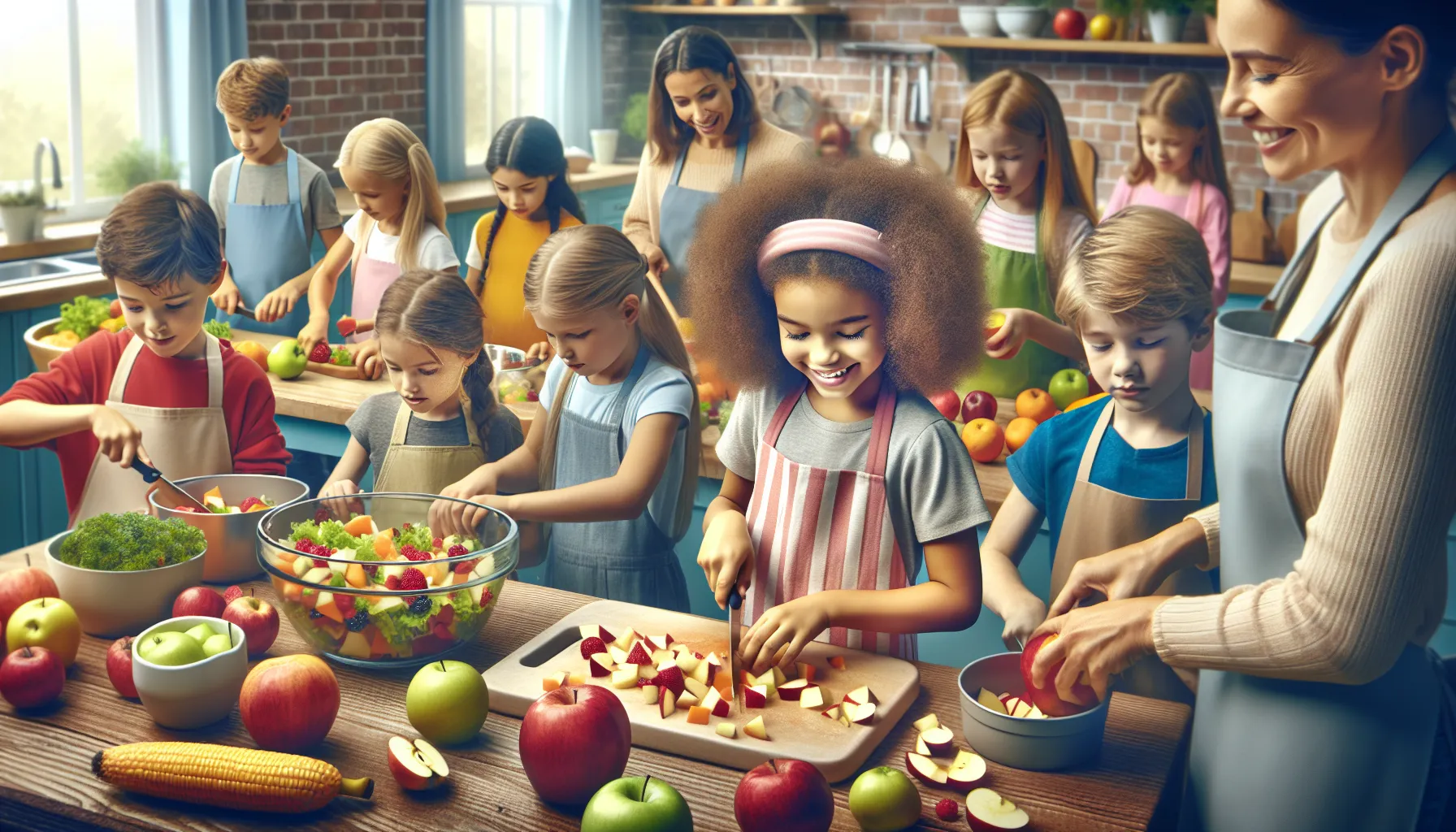
Key Takeaways
- Engaging kids in cooking classes helps spark creativity, boost confidence, and teach essential life skills like teamwork, patience, and problem-solving.
- Kids cooking classes encourage healthy eating habits by exposing children to fresh ingredients and balanced nutrition while fostering an appreciation for wholesome foods.
- Fun class ideas include theme-based cooking, DIY snacks, beginner baking, exploring international cuisines, and holiday-themed recipes, which make learning enjoyable and interactive.
- Choosing age-appropriate recipes, ensuring kitchen safety with proper tools, and incorporating interactive elements are key to organizing successful kids cooking classes.
- Equipping children with kid-friendly tools and appliances, such as safety knives, silicone utensils, and compact cooking gadgets, enhances their confidence while keeping the experience safe and enjoyable.
Cooking with kids is more than just a fun activity—it’s an opportunity to spark creativity, build confidence, and teach essential life skills. From measuring ingredients to mixing and decorating, every step in the kitchen becomes an adventure that engages their curiosity and imagination. But where do we start when planning a cooking class that’s both exciting and educational?
We all want activities that keep kids entertained while helping them learn something new. Cooking classes can do just that, offering hands-on experiences that teach patience, teamwork, and even a bit of science. Whether it’s simple recipes or themed culinary projects, the possibilities are endless. What better way to create lasting memories than by sharing the joy of cooking together?
Benefits Of Kids Cooking Classes
Kids cooking classes go beyond learning recipes. They create opportunities for children to gain valuable skills, build confidence, and develop healthy habits in an engaging environment.
Building Essential Life Skills
Cooking classes offer more than kitchen know-how. Children practice fine motor skills by chopping or stirring, while following recipes enhances their ability to follow directions and solve problems. Measuring ingredients introduces them to basic math concepts, while timing tasks teaches responsibility. These skills are practical and form a foundation for independence.
Encouraging Healthy Eating Habits
Exposure to fresh ingredients during cooking encourages children to try new foods and develop a preference for healthier options. Preparing meals helps them learn about balanced nutrition, making informed choices easier as they grow. How do they respond when they see their efforts transform into a delicious dish? This sense of accomplishment can deepen their appreciation for wholesome foods.
Boosting Confidence And Creativity
Cooking nurtures a child’s ability to think creatively. Decorating cookies or plating dishes lets them express individuality. As they complete each recipe, they gain confidence and self-assurance. How empowering is it for children to create something with their own hands? This experience inspires pride and motivates them to explore more challenges in the kitchen and beyond.
Fun And Engaging Kids Cooking Class Ideas

Cooking classes for kids can be a fun way to build their skills while sparking creativity. They transform learning into an enjoyable activity, offering moments of growth, discovery, and accomplishment. What activities would capture your child’s curiosity and keep them engaged?
Theme-Based Cooking Classes
Classes based on themes make learning exciting and relatable. We can design sessions around favorite storybooks, popular movies, or playful concepts like “Rainbow Foods” or “Breakfast for Dinner.” Themes encourage kids to connect with the task while exploring imaginative ways to prepare meals. For example, a pizza-making class could revolve around creating toppings inspired by characters or scenes from a story.
DIY Snack Creations
Hands-on snack preparation encourages independence. Activities such as building fruit kebabs, assembling colorful sandwich wraps, or crafting yogurt parfaits allow kids to express themselves. They learn how simple ingredients can be combined to create visually appealing, healthy options. These DIY projects also foster decision-making while keeping messes manageable.
Baking Basics For Beginners
Baking introduces kids to essential techniques like measuring, mixing, and managing time. We can focus on simple recipes such as cookies, muffins, or cupcakes that are easy to follow and rewarding to complete. Decorating freshly baked treats gives them a chance to practice creativity while building confidence in their abilities.
Exploring International Cuisines
Introducing children to dishes from different cultures broadens their tastes and knowledge about global traditions. Cooking tacos, sushi rolls, or dumplings not only teaches culinary techniques but also cultivates an appreciation for diversity. Classes can include short discussions about the dish’s origin, making the experience both educational and enjoyable.
Holiday-Themed Cooking Projects
Recipes inspired by upcoming holidays bring festive fun into the kitchen. We can guide kids in making treats like heart-shaped cookies for Valentine’s Day, pumpkin bread for Thanksgiving, or decorated gingerbread houses for winter celebrations. Projects like these let them be part of family traditions, creating memorable experiences tied to seasonal events.
Tips For Organizing Successful Kids Cooking Classes

Planning kids cooking classes requires creativity and careful preparation. These sessions should balance fun and learning, leaving young participants excited and accomplished.
Choosing Age-Appropriate Recipes
Selecting recipes that match children’s skill levels is crucial. For younger kids, focus on simple no-bake treats or dishes with minimal steps, such as sandwiches or fruit salads. Older kids can handle more complex tasks, like chopping vegetables or baking cupcakes. Start with dishes they can relate to and gradually introduce new techniques. What recipes excite the children you work with?
Design the menu to suit short attention spans. Recipes requiring 30 minutes or less, excluding waiting times, work best for kids under 10. Incorporating colorful and familiar ingredients often boosts engagement. For example, making rainbow pasta or decorating cookies makes the process enjoyable and keeps them interested.
Ensuring Safety In The Kitchen
Keeping children safe while they cook is essential. Prepare the workspace by organizing utensils and ingredients beforehand. Use age-appropriate tools, like safety knives for younger participants. Consider assigning an adult helper or extra supervision for tasks like mixing hot liquids or using the oven. How can we balance their learning with staying safe?
Establish clear rules for activities involving heat, sharp objects, or heavy pots. Demonstrate techniques, like proper knife handling or using an oven mitt, before letting them try. Encourage a clean workspace to minimize potential accidents, and keep cleanup supplies close in case of spills.
Making The Experience Interactive And Fun
Engaging children during classes involves more than following a recipe. Turn the session into a participatory adventure by asking questions and sharing fun facts about the ingredients or cooking process. Create conversation around ideas like, “What else could we add to make this dish your own?”
Incorporate games or group tasks to keep classes dynamic. For example, have kids compete in assembling the most creative sandwich or let them vote on their favorite recipe from the session. Providing small rewards, like stickers or certificates, motivates them to stay involved. Focus on decorating and layering for interactive moments, as these encourage creativity while being low-pressure.
Essential Tools And Equipment For Kids Cooking Classes
Setting up a fun and safe cooking environment for kids starts with the right tools. Equipping young chefs with appropriate utensils and appliances boosts their confidence and keeps the experience enjoyable and hassle-free.
Must-Have Utensils For Small Hands
Smaller-sized utensils are crucial for young hands to grip and use comfortably. Items like child-safe knives, measuring cups, spatulas, and whisks offer more control and ease during tasks. For example, using a wavy chopper instead of a sharp knife lets kids safely cut fruits and vegetables. Silicone-tipped utensils can prevent accidents since they’re flexible and gentle on skin.
Durable, lightweight mixing bowls in various sizes make stirring and combining ingredients more manageable. Look for rubber grips or non-slip bottoms to avoid spills. Scissors with rounded tips can help with precision cutting tasks, like shaping cookie dough or trimming herbs.
Kid-Friendly Appliances
Compact, safe-to-use appliances can make a significant difference in kids cooking classes. Hand mixers or manual egg beaters are easier for children to handle than bulky stand mixers. Minimal heat kitchen gadgets, like microwave ovens or toaster ovens, allow kids to participate in cooking while reducing the risk associated with stovetops.
Electric kettles with safety features, such as automatic shut-off or cool-touch exteriors, are helpful for warming water under supervision. Devices like sandwich makers or waffle irons enable kids to create quick treats without relying on complicated equipment. Are there tasks where adding these tools could make the process both safer and simpler for your class?
Conclusion
Kids cooking classes offer a unique blend of fun, learning, and creativity that benefits children in countless ways. By fostering essential skills and encouraging healthy habits, these classes create opportunities for growth while sparking a lifelong love for cooking.
With the right tools, engaging activities, and a focus on safety, we can turn every cooking session into an exciting and memorable experience. Let’s inspire kids to explore, experiment, and enjoy the magic of creating something delicious with their own hands.
Frequently Asked Questions
Why is cooking with kids beneficial?
Cooking with kids promotes creativity, builds confidence, and teaches essential life skills like teamwork, math, and problem-solving. It also helps them develop healthy eating habits and creates lasting family memories.
What are the advantages of kids cooking classes?
Kids cooking classes offer hands-on experiences that improve fine motor skills, introduce basic math concepts, foster creativity, and encourage healthy eating. They also help children gain confidence as they learn to cook independently.
What are some fun ideas for kids cooking classes?
Theme-based sessions (e.g., cooking tied to movies or storybooks), DIY snacks, baking basics, international cuisine exploration, and holiday-themed projects are all engaging and educational for kids.
How do I select recipes for kids cooking classes?
Choose age-appropriate recipes. For younger kids, opt for simple no-bake or easy dishes. Older kids can handle more complex recipes. Prioritize safety and ensure the tasks match their skill levels.
What safety tips should I follow when cooking with kids?
Use age-appropriate tools, establish clear kitchen rules, and supervise tasks closely. Child-safe knives, rubber-grip mixing bowls, and rounded scissors can ensure a safe cooking environment.
What tools are essential for kids in the kitchen?
Essential tools include child-safe knives, smaller-sized utensils, durable mixing bowls with grips, measuring cups, and kid-friendly appliances like hand mixers or microwave ovens. These help enhance safety and ease of use.
How does cooking encourage healthy eating habits in kids?
Cooking exposes children to fresh ingredients and allows them to explore nutritious options. By participating in food preparation, kids are more likely to try and enjoy eating healthy foods.
Can cooking help develop a child’s creativity?
Absolutely! Designing recipes, decorating dishes, and plating food allows children to express their creativity, boosting their confidence and providing a sense of accomplishment.
What are some interactive ways to keep kids engaged in cooking classes?
Incorporate games, group tasks, and interactive moments into the session. Fun challenges like decorating competitions or taste-testing add excitement and creativity to the cooking experience.
How do cooking classes teach math and science?
Cooking involves measuring ingredients, counting, and understanding proportions, which introduce basic math. Simultaneously, observing processes like mixing or baking helps kids learn foundational science concepts.

